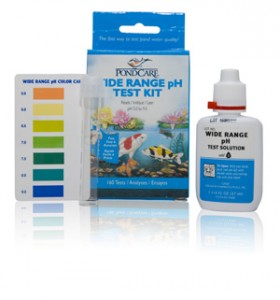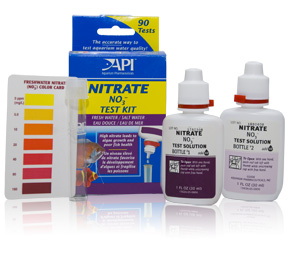Water Test Kits
Water quality is an important factor when it comes to keeping your fish alive. Especially when you are raising a large quantity in a small area. We offer test kits to ensure your fish stay healthy.
 Ph- Ph is measured on a scale from 1, which is acidic, to 14, which is alkaline, with 7 being neutral. The proper ph for different kinds of fish can vary considerably. When it comes to koi, most people agree that a ph of 7.2 to 7.4 is ideal yet we are not sure if anyone has ever asked a koi exactly what ph he likes the best. In cases where the ph is too low (5.5) the fish can experience a condition known as Acidosis which can kill a fish in just a few days. In cases where the ph is too high (9.5) fish can experience a condition known as Alkalosis which can also be fatal. Note: Koi do not like extreme ph changes. We have seen healthy koi living very happily in water with a ph as high as 9. What drives them crazy is when you keep adding acid to lower the ph to 7 and three days later it is back up to 9. If your pond’s ph was steady at 9 or below, don’t touch it. You sould be much more concerned about a ph of 6.8 because you are not far away from a ph crash. Ph- Ph is measured on a scale from 1, which is acidic, to 14, which is alkaline, with 7 being neutral. The proper ph for different kinds of fish can vary considerably. When it comes to koi, most people agree that a ph of 7.2 to 7.4 is ideal yet we are not sure if anyone has ever asked a koi exactly what ph he likes the best. In cases where the ph is too low (5.5) the fish can experience a condition known as Acidosis which can kill a fish in just a few days. In cases where the ph is too high (9.5) fish can experience a condition known as Alkalosis which can also be fatal. Note: Koi do not like extreme ph changes. We have seen healthy koi living very happily in water with a ph as high as 9. What drives them crazy is when you keep adding acid to lower the ph to 7 and three days later it is back up to 9. If your pond’s ph was steady at 9 or below, don’t touch it. You sould be much more concerned about a ph of 6.8 because you are not far away from a ph crash.
phenq reviews 2019, phenq coupon codes, https://www.sportzfuel.com/
|
 Ammonia- When the fish eat food they produce ammonia as a waste. At high levels it will burn the gills of the fish and can cause death. Even at low levels it can create serious health problems. If the gills get burned it reduces the ability for the fish to excrete ammonia through the gills thus causing the ammonia to quickly build up inside the fish. Even low levels of ammonia in a pond for an extended period will cause stress in the fish thereby lowering its ability to fight off bacterial infections and parasites. For this reason, the only acceptable ammonia level in a pond should always be 0. Ammonia- When the fish eat food they produce ammonia as a waste. At high levels it will burn the gills of the fish and can cause death. Even at low levels it can create serious health problems. If the gills get burned it reduces the ability for the fish to excrete ammonia through the gills thus causing the ammonia to quickly build up inside the fish. Even low levels of ammonia in a pond for an extended period will cause stress in the fish thereby lowering its ability to fight off bacterial infections and parasites. For this reason, the only acceptable ammonia level in a pond should always be 0.
|
 Nitrates– are the last chemical produced in the nitrification cycle. They are relatively not toxic compared to ammonia and nitrites but can kill fish at levels over 300 ppm. In most ponds they are consumed by the algae in the pond well before they kill the fish. At levels below 80 ppm nitrates are not a problem. Levels above 80 ppm should be taken seriously though because they can cause redness in the fins and cause fish to become very lethargic. High nitrate levels can also cause stress to the fish, which in turn can prevent soars from healing even whit the use of antibiotics. High levels of nitrates can also stunt the growth of fish. Nitrates– are the last chemical produced in the nitrification cycle. They are relatively not toxic compared to ammonia and nitrites but can kill fish at levels over 300 ppm. In most ponds they are consumed by the algae in the pond well before they kill the fish. At levels below 80 ppm nitrates are not a problem. Levels above 80 ppm should be taken seriously though because they can cause redness in the fins and cause fish to become very lethargic. High nitrate levels can also cause stress to the fish, which in turn can prevent soars from healing even whit the use of antibiotics. High levels of nitrates can also stunt the growth of fish.
|
 Nitrites- When nitrites are present at any level in the pond you need to take it seriously. Nitrites can bind up the red blood cells in fish causing brown blood disease which can be fatal. One sign of high nitrites is the fish gasping at the pond surface. Nitrites- When nitrites are present at any level in the pond you need to take it seriously. Nitrites can bind up the red blood cells in fish causing brown blood disease which can be fatal. One sign of high nitrites is the fish gasping at the pond surface. |
